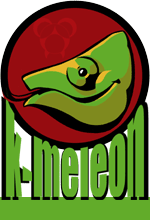K-Meleon
- Footnotes
- Links
- Anchors
- Lists
- Paragraphs
- PRE-formatted text
- Text style
- HTML comments
- !InterWiki:Links
Home > Contribute > WikiHowTo > ExtendedWikiMarkup
You really should learn what the basic WikiMarkup can do for you, before you start to read about more complex features.
Image markup
Images can be inlined into a page using square brackets around the absolute www-address of the image file, like [http://www/image.png].
To align an image (define how the following text flows around it) one can add space characters inside the square brackets before and/or after its http://-address:
- text flows around on the right [http://example.com/image.png ]
- left aligned image [ http://example.com/image.png]
- with spaces on the left and right, a image will display centred
One can also specify to which size a image shall be rescaled by the browser, if this is added as parameters with a query string like appendation; for example [http://www.example.com/image.png?x=200&y=100] would scale the image to 200 pixels width and 100 pixels height. One can also use width= and height= parameters to do so.
If you do not want an image to get inlined into the current page, then just leave out the square brackets around its URL.
Footnotes
To create a footnote {{ a footnote can contain additional information snippets}} use double curly brackets. Usually creating a new page to explain something in more detail is a much better approach, so the footnotes extension is a plugin in ErfurtWiki and thus not available per default.
Links
- a WikiWord will form a hyperlink
- any valid www-address like http://www.example.com/ will do too
- many nonvalid addresses will do too, see file://localhost/etc/passwd
- square brackets around text? makes a hyperlink
- adding (more) [square brackets around it?] is more [[[intuitive?]]] than with other wikis
- a [title | for square bracket links ] can be added using the | character
- the title should be on the left to the linked WikiWord
- but for ewiki it can be on either side, because a http://www can be easily distinguished
- a ["title" for square bracket links] can also be assigned using quotation marks
- the title inside the quotation marks can be on either side of the ["..." wiki link] or [http:// "URL"]
- you can use this too for image links
- this scheme is useful, but incompatible with other WikiSoftware
- the ! exclamation mark or the tilde ~ can be used to escape a !WikiWord or a !http://www.address.net/ and of course escapes ![square brackets] as easily
- instead of square brackets, one may utilize the ^ character to make a ^wikilink? of NotBumpyWords
Anchors
Instead of linking from one page to another page, you can also create links within a single page using anchors. Anchors are defined and referenced using the hash sign directly before a pair of square brackets. #[anchorname] for example would create an anchor. It will be invisible when viewing the page; this exact anchor is placed just above the current "Anchors" header.
To link to an invisible anchor place the hash sign directly before the anchor name within a set of square brackets. For example, #anchorname would link to the anchor described above. It's possible to give anchor links any desired name just like regular links.
It is not possible to link to anchors on another page from within the wiki. It is possible to link to these hidden anchors from other parts of the internet including the K-Meleon forums.
Requiring a pagename in front of the anchor name to reference to it is some overhead but the only senseful way to create valid links. So to create links to an anchor on the current page one must write [CurrentPage#anchor].
Anchors and anchor references can and should also be entitled using quotation marks or the dash sign:
- #[anchor "Title for this anchor"].
- [#anchor2 "anchor2 jump link title"]
Lists
- one can create lists by writing an asterisk at the beginning of a line
- or enumerated lists by using a hash sign instead
- instead of the asterisk the - minus character can be used sometimes
- definition lists can be created using :: or ;: at the line start or as sublist
- definition
- explanation
- anotherdef
- another description
Paragraphs
- lists automatically make up a new paragraph
- every block of text (without empty lines) will form a paragraph
Text can be indented using TABs or spaces at the beginning of a line:
PRE-formatted text
If you wish text to appear "pre-formatted" then
all you have to do is to start that paragraph using
the code "<pre>" at the line start. End that
paragraph again by writing "</pre>" at the beginning
of a line.
Most people will already know that markup, as it is a plain <HTML> tag, and so will feel very comfortable with it. But note that "<pre>" and "</pre>" must be written in all-lowercase, else it won't apply!
Note that WikiMarkup between "<pre>" and "</pre>" is interpreted! Enclose your text in "<code>" and "</code>" to get it displayed exactly as you entered it:
for(var i=0;i<100;i++) i++; // there's no enlarged text on this line because WikiMarkup is ignored
Text style
- text can be made bold
- or italic
- superscript or subscript
- or even underlined
And most of these things can be combined.
HTML comments
- HTML-comments can be inserted using a <!-- at a line start, but don't add the --> as it will be appended automatically and would appear as text
- use this trick to hide informations from plain visitors (only somebody who edits a page can read comments)
InterWiki:Links
- there exist abbreviations for concurrent wikis on the web
- to reference a page from another wiki, just prepend the Wikis name and a colon before the remote WikiPageName:
- that's why you shouldn't use the colon inside of square brackets

 English
English